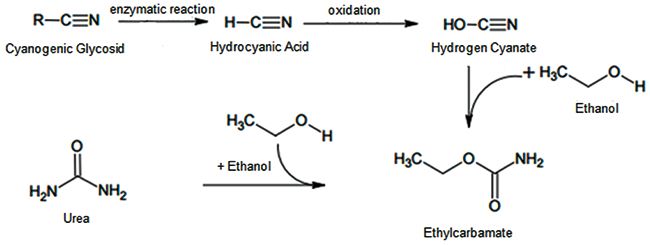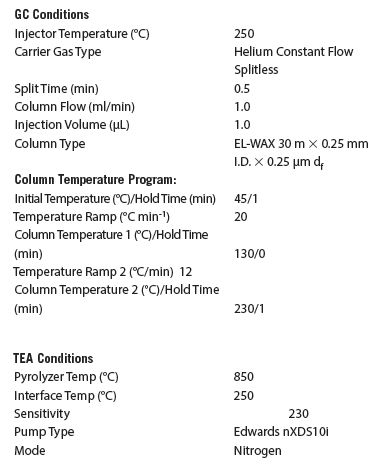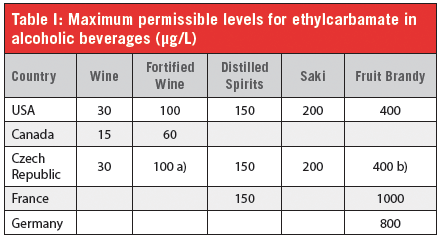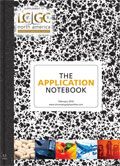Ethylcarbamate (Urethane) in Distilled Alcoholic Beverages
The Application Notebook
A variety of alcoholic beverages purchased within the UK were analyzed for the presence of Ethylcarbamate. A 1 µL injection of these alcoholic beverages were analyzed on an Ellutia 200 GC followed by detection on an Ellutia 820 TEA working in nitrogen detection mode. This mode of analysis detects nitrogen containing compounds within a sample. The Ellutia 810/820 systems are able to analyse various nitro or nitroso compounds, utilizing the selectivity available through nitrogen or nitroso modes. Nitrogen mode utilizes the catalytic pyrolyzer tube, oxygen reactor, and higher temperatures to detect nitrogen compounds. Results for various alcoholic beverages are shown in Figure 3. The samples were found to have various low levels of ethylcarbamate, the system was optimized through levels of oxygen input and EHT sensitivity. The samples were then analyzed adopting a standard addition approach.
Ethylcarbamate (Urethane, C2H5OCONH2) is a known genotoxic carcinogen that commonly exists in fermented food and beverages, as it can be generated during the fermentation and distillation process. Ethylcarbamate has been detected in various alcoholic beverages that have been fermented, as well as other products including bread, yogurt, cheese, soy sauce, and vinegar. Primary production of ethylcarbamate arises when cyanate reacts with ethanol to produce carbamate esters, an example pathway is shown in Figure 1.

Figure 1: The formation of ethylcarbamate from ethanol and hydrogen cyanate (top) or from ethanol and urea (bottom).
Ethylcarbamate was reclassified as a 2A carcinogen by the International Agency for Research on Cancer (IARC) in 2007 and is now regulated in many countries. Levels within food have comparably little effect of increasing chances of developing cancer, however when partnered with ethyl alcohol intake, the risk increases greatly. Calculated estimate amounts of consumption per day are 15 ng/kg without ethyl alcohol and 80 ng/kg with ethyl alcohol. There are currently no standardized limits for maximum levels of ethylcarbamate in the European Union (EU). The recommended maximum levels for ethylcarbamate in alcoholic beverages for different countries are shown in Table I. An estimated daily dietary exposure of 65–558 ng/kg by weight per day of ethylcarbamate within food and drink consumption was calculated by the European Food Standard Authority (EFSA). EFSA also noted that these levels needed to be monitored and reduced by manufacturers. This can be highlighted by looking at the impact of alcoholic beverages, for example, by consuming a small glass of wine with your evening meal potentially could result in an approximate 3700 ng/kg addition to the amount of ethylcarbamate already contained within the food.

Figure 2 shows a chromatogram of a 1 µL injection of 1% solution of ethylcarbamate in deionised water. Under the current method, ethylcarbamate possess a retention time of approximately 6.5 min.

Table I: Maximum permissible levels for ethylcarbamate in alcoholic beverages (µg/L)
A variety of alcoholic beverages purchased within the UK were analyzed for the presence of Ethylcarbamate. A 1 µL injection of these alcoholic beverages were analyzed on an Ellutia 200 GC followed by detection on an Ellutia 820 TEA working in nitrogen detection mode. This mode of analysis detects nitrogen containing compounds within a sample. The Ellutia 810/820 systems are able to analyse various nitro or nitroso compounds, utilizing the selectivity available through nitrogen or nitroso modes. Nitrogen mode utilizes the catalytic pyrolyzer tube, oxygen reactor, and higher temperatures to detect nitrogen compounds. Results for various alcoholic beverages are shown in Figure 3. The samples were found to have various low levels of ethylcarbamate, the system was optimized through levels of oxygen input and EHT sensitivity. The samples were then analyzed adopting a standard addition approach.

Figure 2: A chromatogram of a 1 µL injection of 1% solution of ethylcarbamate.

Figure 3: Chromatogram of five alcoholic beverages and a 100 ppb ethylcarbamate standard.

Table II: Results for each five samples and a 100 ppb standard

Ellutia
12-16 Sedgeway Business Park,
Witchford, Cambridgeshire CB62HY, UK
tel. +44 1353 669916
Website: www.ellutia.com

New Study Reviews Chromatography Methods for Flavonoid Analysis
April 21st 2025Flavonoids are widely used metabolites that carry out various functions in different industries, such as food and cosmetics. Detecting, separating, and quantifying them in fruit species can be a complicated process.
Analytical Challenges in Measuring Migration from Food Contact Materials
November 2nd 2015Food contact materials contain low molecular weight additives and processing aids which can migrate into foods leading to trace levels of contamination. Food safety is ensured through regulations, comprising compositional controls and migration limits, which present a significant analytical challenge to the food industry to ensure compliance and demonstrate due diligence. Of the various analytical approaches, LC-MS/MS has proved to be an essential tool in monitoring migration of target compounds into foods, and more sophisticated approaches such as LC-high resolution MS (Orbitrap) are being increasingly used for untargeted analysis to monitor non-intentionally added substances. This podcast will provide an overview to this area, illustrated with various applications showing current approaches being employed.

.png&w=3840&q=75)

.png&w=3840&q=75)



.png&w=3840&q=75)



.png&w=3840&q=75)















